Motivation and its Theories: An Annotated Bibliography Analysis
VerifiedAdded on 2021/05/30
|12
|3383
|272
Annotated Bibliography
AI Summary
This annotated bibliography examines various theories of motivation and their application in the workplace. It analyzes nine different sources, including journal articles and studies, focusing on how motivation impacts employee performance and leadership effectiveness. The bibliography covers key concepts such as Maslow’s Hierarchy of Needs, Herzberg’s Two-Factor Model, and the Regulatory Focus Theory, exploring intrinsic and extrinsic motivation factors. It highlights the importance of ethical leadership, social and emotional intelligence, and the role of gamification in enhancing employee engagement. The sources discuss the differences between generations in the workplace and the impact of factors like ethical and religious motivations. The bibliography provides a comprehensive overview of how leaders can apply different motivational strategies to improve employee performance, foster innovation, and create a positive work environment.
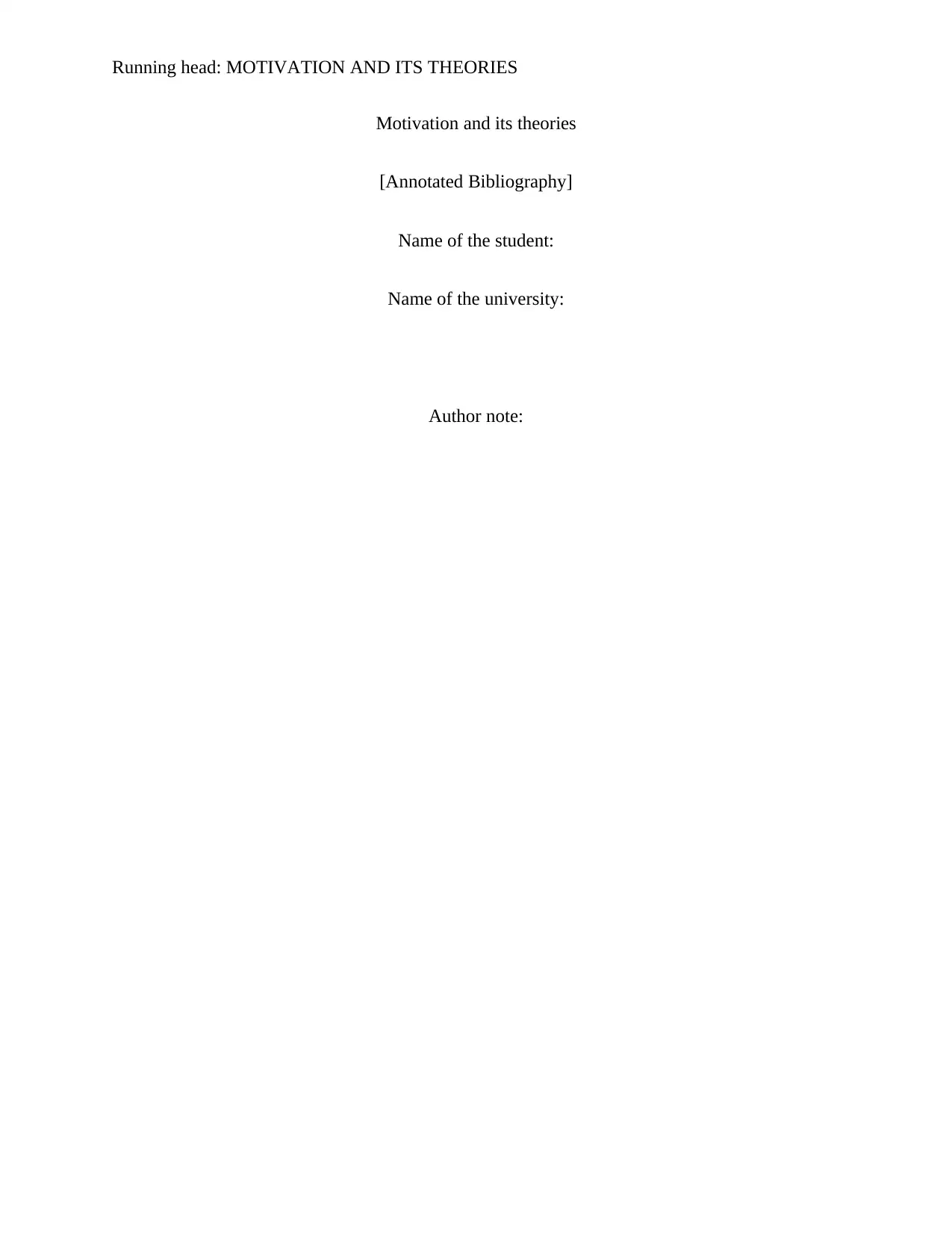
Running head: MOTIVATION AND ITS THEORIES
Motivation and its theories
[Annotated Bibliography]
Name of the student:
Name of the university:
Author note:
Motivation and its theories
[Annotated Bibliography]
Name of the student:
Name of the university:
Author note:
Paraphrase This Document
Need a fresh take? Get an instant paraphrase of this document with our AI Paraphraser
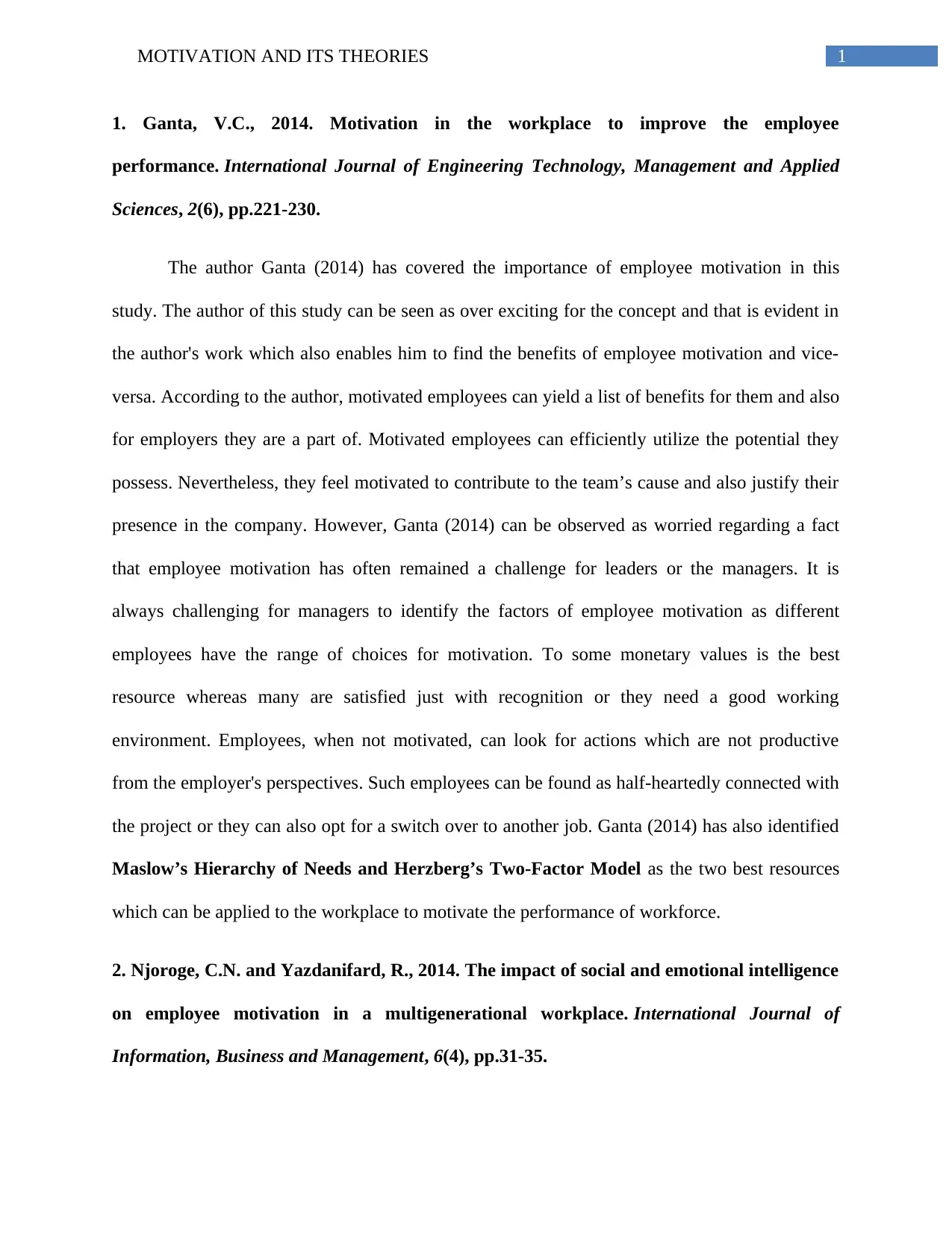
1MOTIVATION AND ITS THEORIES
1. Ganta, V.C., 2014. Motivation in the workplace to improve the employee
performance. International Journal of Engineering Technology, Management and Applied
Sciences, 2(6), pp.221-230.
The author Ganta (2014) has covered the importance of employee motivation in this
study. The author of this study can be seen as over exciting for the concept and that is evident in
the author's work which also enables him to find the benefits of employee motivation and vice-
versa. According to the author, motivated employees can yield a list of benefits for them and also
for employers they are a part of. Motivated employees can efficiently utilize the potential they
possess. Nevertheless, they feel motivated to contribute to the team’s cause and also justify their
presence in the company. However, Ganta (2014) can be observed as worried regarding a fact
that employee motivation has often remained a challenge for leaders or the managers. It is
always challenging for managers to identify the factors of employee motivation as different
employees have the range of choices for motivation. To some monetary values is the best
resource whereas many are satisfied just with recognition or they need a good working
environment. Employees, when not motivated, can look for actions which are not productive
from the employer's perspectives. Such employees can be found as half-heartedly connected with
the project or they can also opt for a switch over to another job. Ganta (2014) has also identified
Maslow’s Hierarchy of Needs and Herzberg’s Two-Factor Model as the two best resources
which can be applied to the workplace to motivate the performance of workforce.
2. Njoroge, C.N. and Yazdanifard, R., 2014. The impact of social and emotional intelligence
on employee motivation in a multigenerational workplace. International Journal of
Information, Business and Management, 6(4), pp.31-35.
1. Ganta, V.C., 2014. Motivation in the workplace to improve the employee
performance. International Journal of Engineering Technology, Management and Applied
Sciences, 2(6), pp.221-230.
The author Ganta (2014) has covered the importance of employee motivation in this
study. The author of this study can be seen as over exciting for the concept and that is evident in
the author's work which also enables him to find the benefits of employee motivation and vice-
versa. According to the author, motivated employees can yield a list of benefits for them and also
for employers they are a part of. Motivated employees can efficiently utilize the potential they
possess. Nevertheless, they feel motivated to contribute to the team’s cause and also justify their
presence in the company. However, Ganta (2014) can be observed as worried regarding a fact
that employee motivation has often remained a challenge for leaders or the managers. It is
always challenging for managers to identify the factors of employee motivation as different
employees have the range of choices for motivation. To some monetary values is the best
resource whereas many are satisfied just with recognition or they need a good working
environment. Employees, when not motivated, can look for actions which are not productive
from the employer's perspectives. Such employees can be found as half-heartedly connected with
the project or they can also opt for a switch over to another job. Ganta (2014) has also identified
Maslow’s Hierarchy of Needs and Herzberg’s Two-Factor Model as the two best resources
which can be applied to the workplace to motivate the performance of workforce.
2. Njoroge, C.N. and Yazdanifard, R., 2014. The impact of social and emotional intelligence
on employee motivation in a multigenerational workplace. International Journal of
Information, Business and Management, 6(4), pp.31-35.
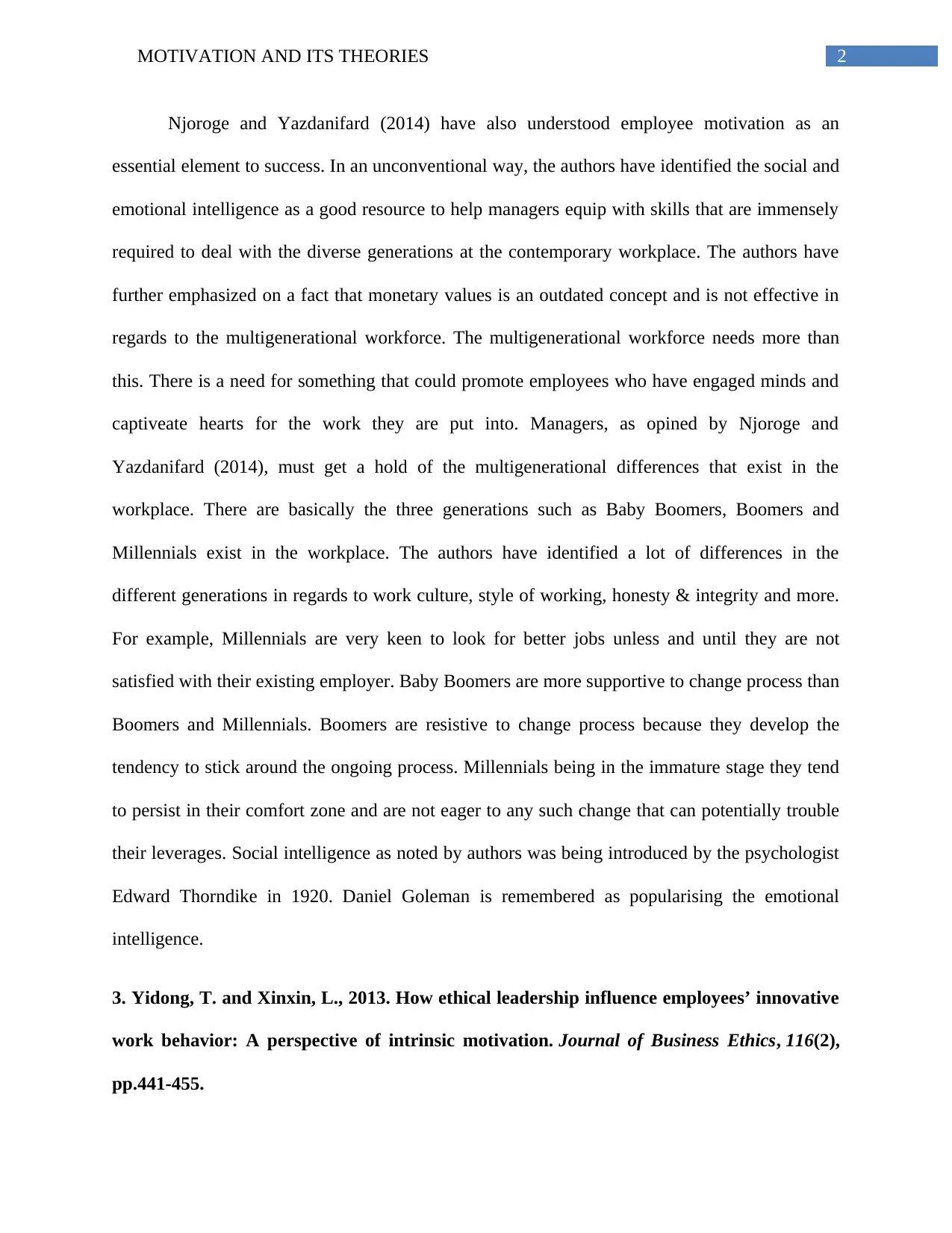
2MOTIVATION AND ITS THEORIES
Njoroge and Yazdanifard (2014) have also understood employee motivation as an
essential element to success. In an unconventional way, the authors have identified the social and
emotional intelligence as a good resource to help managers equip with skills that are immensely
required to deal with the diverse generations at the contemporary workplace. The authors have
further emphasized on a fact that monetary values is an outdated concept and is not effective in
regards to the multigenerational workforce. The multigenerational workforce needs more than
this. There is a need for something that could promote employees who have engaged minds and
captiveate hearts for the work they are put into. Managers, as opined by Njoroge and
Yazdanifard (2014), must get a hold of the multigenerational differences that exist in the
workplace. There are basically the three generations such as Baby Boomers, Boomers and
Millennials exist in the workplace. The authors have identified a lot of differences in the
different generations in regards to work culture, style of working, honesty & integrity and more.
For example, Millennials are very keen to look for better jobs unless and until they are not
satisfied with their existing employer. Baby Boomers are more supportive to change process than
Boomers and Millennials. Boomers are resistive to change process because they develop the
tendency to stick around the ongoing process. Millennials being in the immature stage they tend
to persist in their comfort zone and are not eager to any such change that can potentially trouble
their leverages. Social intelligence as noted by authors was being introduced by the psychologist
Edward Thorndike in 1920. Daniel Goleman is remembered as popularising the emotional
intelligence.
3. Yidong, T. and Xinxin, L., 2013. How ethical leadership influence employees’ innovative
work behavior: A perspective of intrinsic motivation. Journal of Business Ethics, 116(2),
pp.441-455.
Njoroge and Yazdanifard (2014) have also understood employee motivation as an
essential element to success. In an unconventional way, the authors have identified the social and
emotional intelligence as a good resource to help managers equip with skills that are immensely
required to deal with the diverse generations at the contemporary workplace. The authors have
further emphasized on a fact that monetary values is an outdated concept and is not effective in
regards to the multigenerational workforce. The multigenerational workforce needs more than
this. There is a need for something that could promote employees who have engaged minds and
captiveate hearts for the work they are put into. Managers, as opined by Njoroge and
Yazdanifard (2014), must get a hold of the multigenerational differences that exist in the
workplace. There are basically the three generations such as Baby Boomers, Boomers and
Millennials exist in the workplace. The authors have identified a lot of differences in the
different generations in regards to work culture, style of working, honesty & integrity and more.
For example, Millennials are very keen to look for better jobs unless and until they are not
satisfied with their existing employer. Baby Boomers are more supportive to change process than
Boomers and Millennials. Boomers are resistive to change process because they develop the
tendency to stick around the ongoing process. Millennials being in the immature stage they tend
to persist in their comfort zone and are not eager to any such change that can potentially trouble
their leverages. Social intelligence as noted by authors was being introduced by the psychologist
Edward Thorndike in 1920. Daniel Goleman is remembered as popularising the emotional
intelligence.
3. Yidong, T. and Xinxin, L., 2013. How ethical leadership influence employees’ innovative
work behavior: A perspective of intrinsic motivation. Journal of Business Ethics, 116(2),
pp.441-455.
⊘ This is a preview!⊘
Do you want full access?
Subscribe today to unlock all pages.

Trusted by 1+ million students worldwide
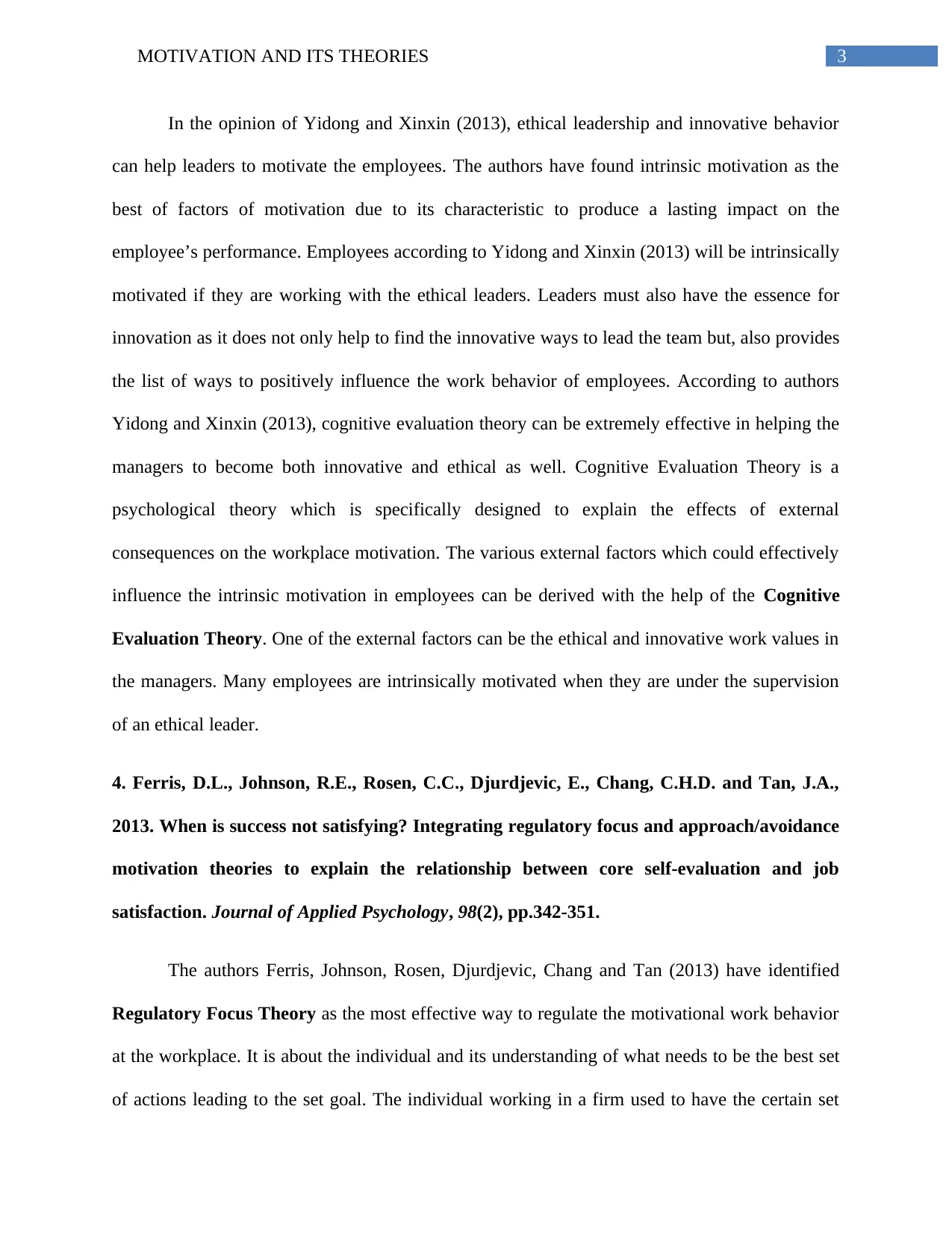
3MOTIVATION AND ITS THEORIES
In the opinion of Yidong and Xinxin (2013), ethical leadership and innovative behavior
can help leaders to motivate the employees. The authors have found intrinsic motivation as the
best of factors of motivation due to its characteristic to produce a lasting impact on the
employee’s performance. Employees according to Yidong and Xinxin (2013) will be intrinsically
motivated if they are working with the ethical leaders. Leaders must also have the essence for
innovation as it does not only help to find the innovative ways to lead the team but, also provides
the list of ways to positively influence the work behavior of employees. According to authors
Yidong and Xinxin (2013), cognitive evaluation theory can be extremely effective in helping the
managers to become both innovative and ethical as well. Cognitive Evaluation Theory is a
psychological theory which is specifically designed to explain the effects of external
consequences on the workplace motivation. The various external factors which could effectively
influence the intrinsic motivation in employees can be derived with the help of the Cognitive
Evaluation Theory. One of the external factors can be the ethical and innovative work values in
the managers. Many employees are intrinsically motivated when they are under the supervision
of an ethical leader.
4. Ferris, D.L., Johnson, R.E., Rosen, C.C., Djurdjevic, E., Chang, C.H.D. and Tan, J.A.,
2013. When is success not satisfying? Integrating regulatory focus and approach/avoidance
motivation theories to explain the relationship between core self-evaluation and job
satisfaction. Journal of Applied Psychology, 98(2), pp.342-351.
The authors Ferris, Johnson, Rosen, Djurdjevic, Chang and Tan (2013) have identified
Regulatory Focus Theory as the most effective way to regulate the motivational work behavior
at the workplace. It is about the individual and its understanding of what needs to be the best set
of actions leading to the set goal. The individual working in a firm used to have the certain set
In the opinion of Yidong and Xinxin (2013), ethical leadership and innovative behavior
can help leaders to motivate the employees. The authors have found intrinsic motivation as the
best of factors of motivation due to its characteristic to produce a lasting impact on the
employee’s performance. Employees according to Yidong and Xinxin (2013) will be intrinsically
motivated if they are working with the ethical leaders. Leaders must also have the essence for
innovation as it does not only help to find the innovative ways to lead the team but, also provides
the list of ways to positively influence the work behavior of employees. According to authors
Yidong and Xinxin (2013), cognitive evaluation theory can be extremely effective in helping the
managers to become both innovative and ethical as well. Cognitive Evaluation Theory is a
psychological theory which is specifically designed to explain the effects of external
consequences on the workplace motivation. The various external factors which could effectively
influence the intrinsic motivation in employees can be derived with the help of the Cognitive
Evaluation Theory. One of the external factors can be the ethical and innovative work values in
the managers. Many employees are intrinsically motivated when they are under the supervision
of an ethical leader.
4. Ferris, D.L., Johnson, R.E., Rosen, C.C., Djurdjevic, E., Chang, C.H.D. and Tan, J.A.,
2013. When is success not satisfying? Integrating regulatory focus and approach/avoidance
motivation theories to explain the relationship between core self-evaluation and job
satisfaction. Journal of Applied Psychology, 98(2), pp.342-351.
The authors Ferris, Johnson, Rosen, Djurdjevic, Chang and Tan (2013) have identified
Regulatory Focus Theory as the most effective way to regulate the motivational work behavior
at the workplace. It is about the individual and its understanding of what needs to be the best set
of actions leading to the set goal. The individual working in a firm used to have the certain set
Paraphrase This Document
Need a fresh take? Get an instant paraphrase of this document with our AI Paraphraser
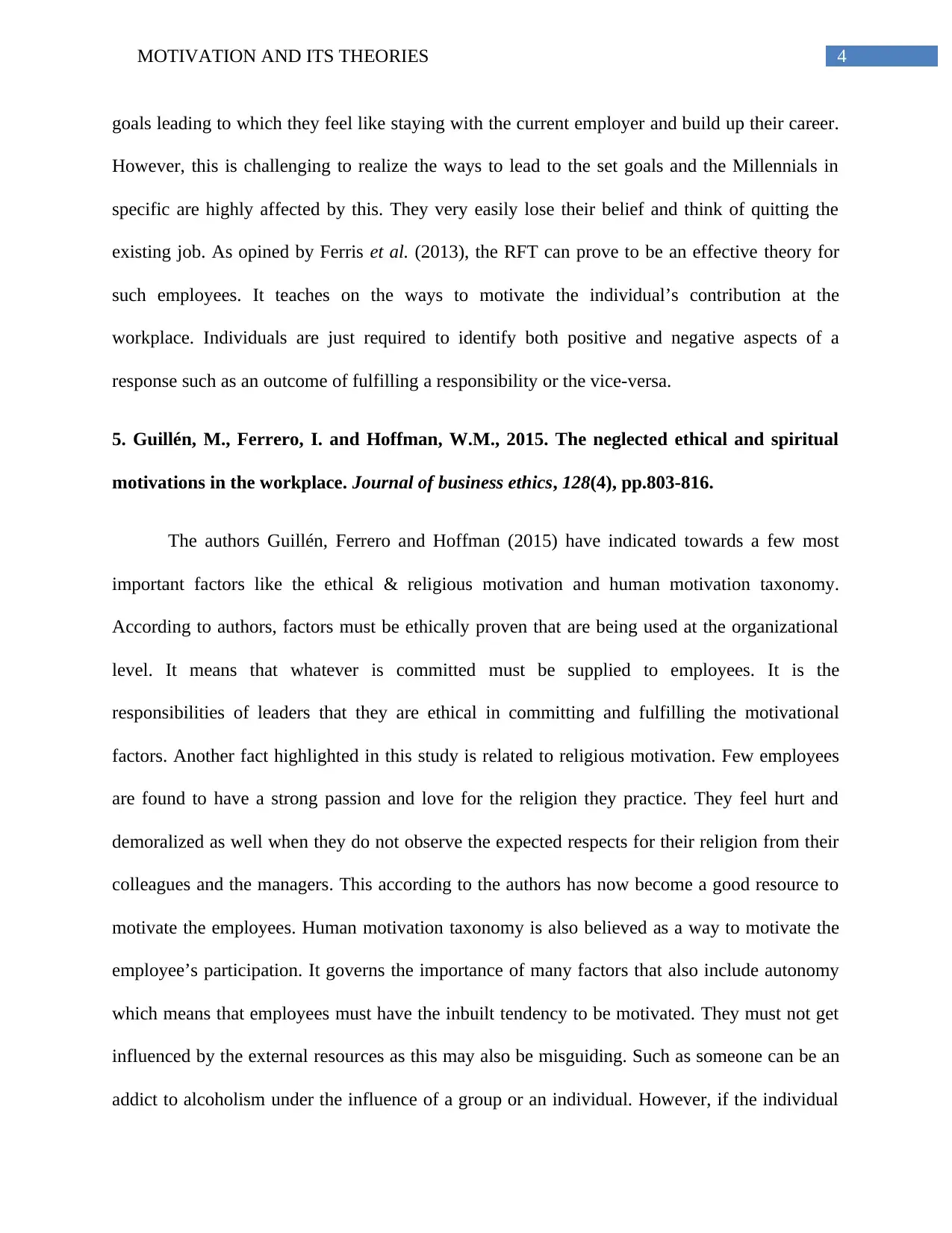
4MOTIVATION AND ITS THEORIES
goals leading to which they feel like staying with the current employer and build up their career.
However, this is challenging to realize the ways to lead to the set goals and the Millennials in
specific are highly affected by this. They very easily lose their belief and think of quitting the
existing job. As opined by Ferris et al. (2013), the RFT can prove to be an effective theory for
such employees. It teaches on the ways to motivate the individual’s contribution at the
workplace. Individuals are just required to identify both positive and negative aspects of a
response such as an outcome of fulfilling a responsibility or the vice-versa.
5. Guillén, M., Ferrero, I. and Hoffman, W.M., 2015. The neglected ethical and spiritual
motivations in the workplace. Journal of business ethics, 128(4), pp.803-816.
The authors Guillén, Ferrero and Hoffman (2015) have indicated towards a few most
important factors like the ethical & religious motivation and human motivation taxonomy.
According to authors, factors must be ethically proven that are being used at the organizational
level. It means that whatever is committed must be supplied to employees. It is the
responsibilities of leaders that they are ethical in committing and fulfilling the motivational
factors. Another fact highlighted in this study is related to religious motivation. Few employees
are found to have a strong passion and love for the religion they practice. They feel hurt and
demoralized as well when they do not observe the expected respects for their religion from their
colleagues and the managers. This according to the authors has now become a good resource to
motivate the employees. Human motivation taxonomy is also believed as a way to motivate the
employee’s participation. It governs the importance of many factors that also include autonomy
which means that employees must have the inbuilt tendency to be motivated. They must not get
influenced by the external resources as this may also be misguiding. Such as someone can be an
addict to alcoholism under the influence of a group or an individual. However, if the individual
goals leading to which they feel like staying with the current employer and build up their career.
However, this is challenging to realize the ways to lead to the set goals and the Millennials in
specific are highly affected by this. They very easily lose their belief and think of quitting the
existing job. As opined by Ferris et al. (2013), the RFT can prove to be an effective theory for
such employees. It teaches on the ways to motivate the individual’s contribution at the
workplace. Individuals are just required to identify both positive and negative aspects of a
response such as an outcome of fulfilling a responsibility or the vice-versa.
5. Guillén, M., Ferrero, I. and Hoffman, W.M., 2015. The neglected ethical and spiritual
motivations in the workplace. Journal of business ethics, 128(4), pp.803-816.
The authors Guillén, Ferrero and Hoffman (2015) have indicated towards a few most
important factors like the ethical & religious motivation and human motivation taxonomy.
According to authors, factors must be ethically proven that are being used at the organizational
level. It means that whatever is committed must be supplied to employees. It is the
responsibilities of leaders that they are ethical in committing and fulfilling the motivational
factors. Another fact highlighted in this study is related to religious motivation. Few employees
are found to have a strong passion and love for the religion they practice. They feel hurt and
demoralized as well when they do not observe the expected respects for their religion from their
colleagues and the managers. This according to the authors has now become a good resource to
motivate the employees. Human motivation taxonomy is also believed as a way to motivate the
employee’s participation. It governs the importance of many factors that also include autonomy
which means that employees must have the inbuilt tendency to be motivated. They must not get
influenced by the external resources as this may also be misguiding. Such as someone can be an
addict to alcoholism under the influence of a group or an individual. However, if the individual
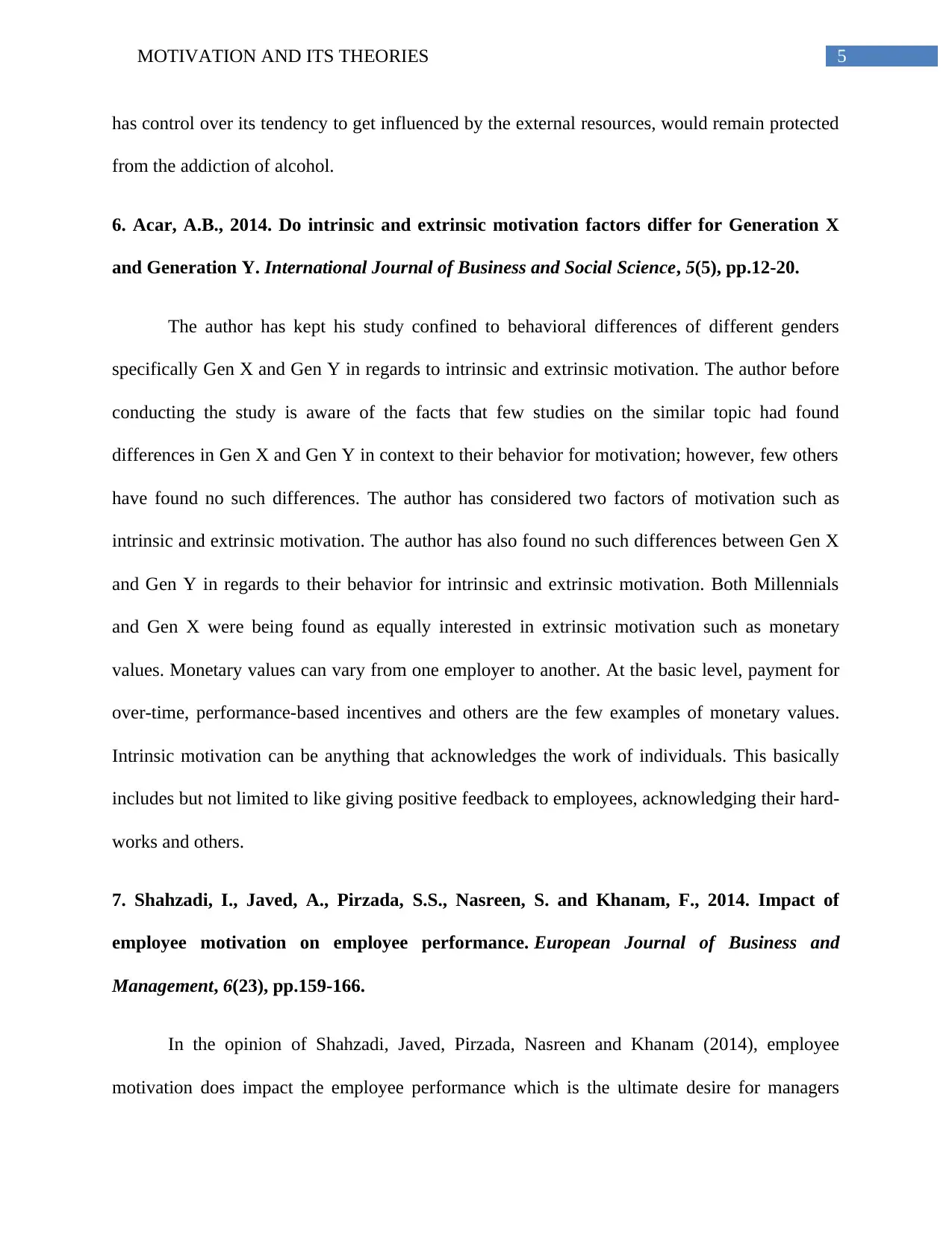
5MOTIVATION AND ITS THEORIES
has control over its tendency to get influenced by the external resources, would remain protected
from the addiction of alcohol.
6. Acar, A.B., 2014. Do intrinsic and extrinsic motivation factors differ for Generation X
and Generation Y. International Journal of Business and Social Science, 5(5), pp.12-20.
The author has kept his study confined to behavioral differences of different genders
specifically Gen X and Gen Y in regards to intrinsic and extrinsic motivation. The author before
conducting the study is aware of the facts that few studies on the similar topic had found
differences in Gen X and Gen Y in context to their behavior for motivation; however, few others
have found no such differences. The author has considered two factors of motivation such as
intrinsic and extrinsic motivation. The author has also found no such differences between Gen X
and Gen Y in regards to their behavior for intrinsic and extrinsic motivation. Both Millennials
and Gen X were being found as equally interested in extrinsic motivation such as monetary
values. Monetary values can vary from one employer to another. At the basic level, payment for
over-time, performance-based incentives and others are the few examples of monetary values.
Intrinsic motivation can be anything that acknowledges the work of individuals. This basically
includes but not limited to like giving positive feedback to employees, acknowledging their hard-
works and others.
7. Shahzadi, I., Javed, A., Pirzada, S.S., Nasreen, S. and Khanam, F., 2014. Impact of
employee motivation on employee performance. European Journal of Business and
Management, 6(23), pp.159-166.
In the opinion of Shahzadi, Javed, Pirzada, Nasreen and Khanam (2014), employee
motivation does impact the employee performance which is the ultimate desire for managers
has control over its tendency to get influenced by the external resources, would remain protected
from the addiction of alcohol.
6. Acar, A.B., 2014. Do intrinsic and extrinsic motivation factors differ for Generation X
and Generation Y. International Journal of Business and Social Science, 5(5), pp.12-20.
The author has kept his study confined to behavioral differences of different genders
specifically Gen X and Gen Y in regards to intrinsic and extrinsic motivation. The author before
conducting the study is aware of the facts that few studies on the similar topic had found
differences in Gen X and Gen Y in context to their behavior for motivation; however, few others
have found no such differences. The author has considered two factors of motivation such as
intrinsic and extrinsic motivation. The author has also found no such differences between Gen X
and Gen Y in regards to their behavior for intrinsic and extrinsic motivation. Both Millennials
and Gen X were being found as equally interested in extrinsic motivation such as monetary
values. Monetary values can vary from one employer to another. At the basic level, payment for
over-time, performance-based incentives and others are the few examples of monetary values.
Intrinsic motivation can be anything that acknowledges the work of individuals. This basically
includes but not limited to like giving positive feedback to employees, acknowledging their hard-
works and others.
7. Shahzadi, I., Javed, A., Pirzada, S.S., Nasreen, S. and Khanam, F., 2014. Impact of
employee motivation on employee performance. European Journal of Business and
Management, 6(23), pp.159-166.
In the opinion of Shahzadi, Javed, Pirzada, Nasreen and Khanam (2014), employee
motivation does impact the employee performance which is the ultimate desire for managers
⊘ This is a preview!⊘
Do you want full access?
Subscribe today to unlock all pages.

Trusted by 1+ million students worldwide
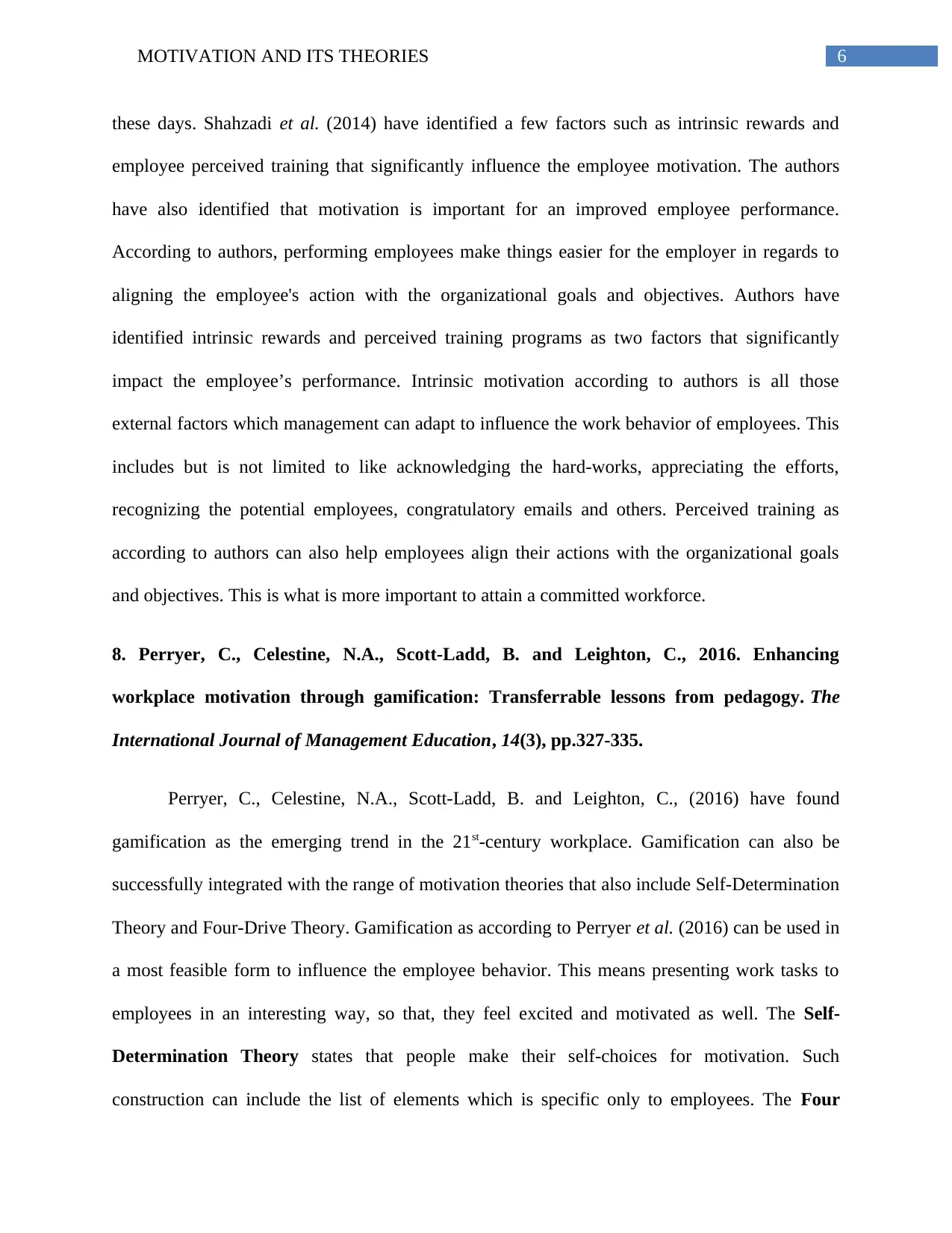
6MOTIVATION AND ITS THEORIES
these days. Shahzadi et al. (2014) have identified a few factors such as intrinsic rewards and
employee perceived training that significantly influence the employee motivation. The authors
have also identified that motivation is important for an improved employee performance.
According to authors, performing employees make things easier for the employer in regards to
aligning the employee's action with the organizational goals and objectives. Authors have
identified intrinsic rewards and perceived training programs as two factors that significantly
impact the employee’s performance. Intrinsic motivation according to authors is all those
external factors which management can adapt to influence the work behavior of employees. This
includes but is not limited to like acknowledging the hard-works, appreciating the efforts,
recognizing the potential employees, congratulatory emails and others. Perceived training as
according to authors can also help employees align their actions with the organizational goals
and objectives. This is what is more important to attain a committed workforce.
8. Perryer, C., Celestine, N.A., Scott-Ladd, B. and Leighton, C., 2016. Enhancing
workplace motivation through gamification: Transferrable lessons from pedagogy. The
International Journal of Management Education, 14(3), pp.327-335.
Perryer, C., Celestine, N.A., Scott-Ladd, B. and Leighton, C., (2016) have found
gamification as the emerging trend in the 21st-century workplace. Gamification can also be
successfully integrated with the range of motivation theories that also include Self-Determination
Theory and Four-Drive Theory. Gamification as according to Perryer et al. (2016) can be used in
a most feasible form to influence the employee behavior. This means presenting work tasks to
employees in an interesting way, so that, they feel excited and motivated as well. The Self-
Determination Theory states that people make their self-choices for motivation. Such
construction can include the list of elements which is specific only to employees. The Four
these days. Shahzadi et al. (2014) have identified a few factors such as intrinsic rewards and
employee perceived training that significantly influence the employee motivation. The authors
have also identified that motivation is important for an improved employee performance.
According to authors, performing employees make things easier for the employer in regards to
aligning the employee's action with the organizational goals and objectives. Authors have
identified intrinsic rewards and perceived training programs as two factors that significantly
impact the employee’s performance. Intrinsic motivation according to authors is all those
external factors which management can adapt to influence the work behavior of employees. This
includes but is not limited to like acknowledging the hard-works, appreciating the efforts,
recognizing the potential employees, congratulatory emails and others. Perceived training as
according to authors can also help employees align their actions with the organizational goals
and objectives. This is what is more important to attain a committed workforce.
8. Perryer, C., Celestine, N.A., Scott-Ladd, B. and Leighton, C., 2016. Enhancing
workplace motivation through gamification: Transferrable lessons from pedagogy. The
International Journal of Management Education, 14(3), pp.327-335.
Perryer, C., Celestine, N.A., Scott-Ladd, B. and Leighton, C., (2016) have found
gamification as the emerging trend in the 21st-century workplace. Gamification can also be
successfully integrated with the range of motivation theories that also include Self-Determination
Theory and Four-Drive Theory. Gamification as according to Perryer et al. (2016) can be used in
a most feasible form to influence the employee behavior. This means presenting work tasks to
employees in an interesting way, so that, they feel excited and motivated as well. The Self-
Determination Theory states that people make their self-choices for motivation. Such
construction can include the list of elements which is specific only to employees. The Four
Paraphrase This Document
Need a fresh take? Get an instant paraphrase of this document with our AI Paraphraser
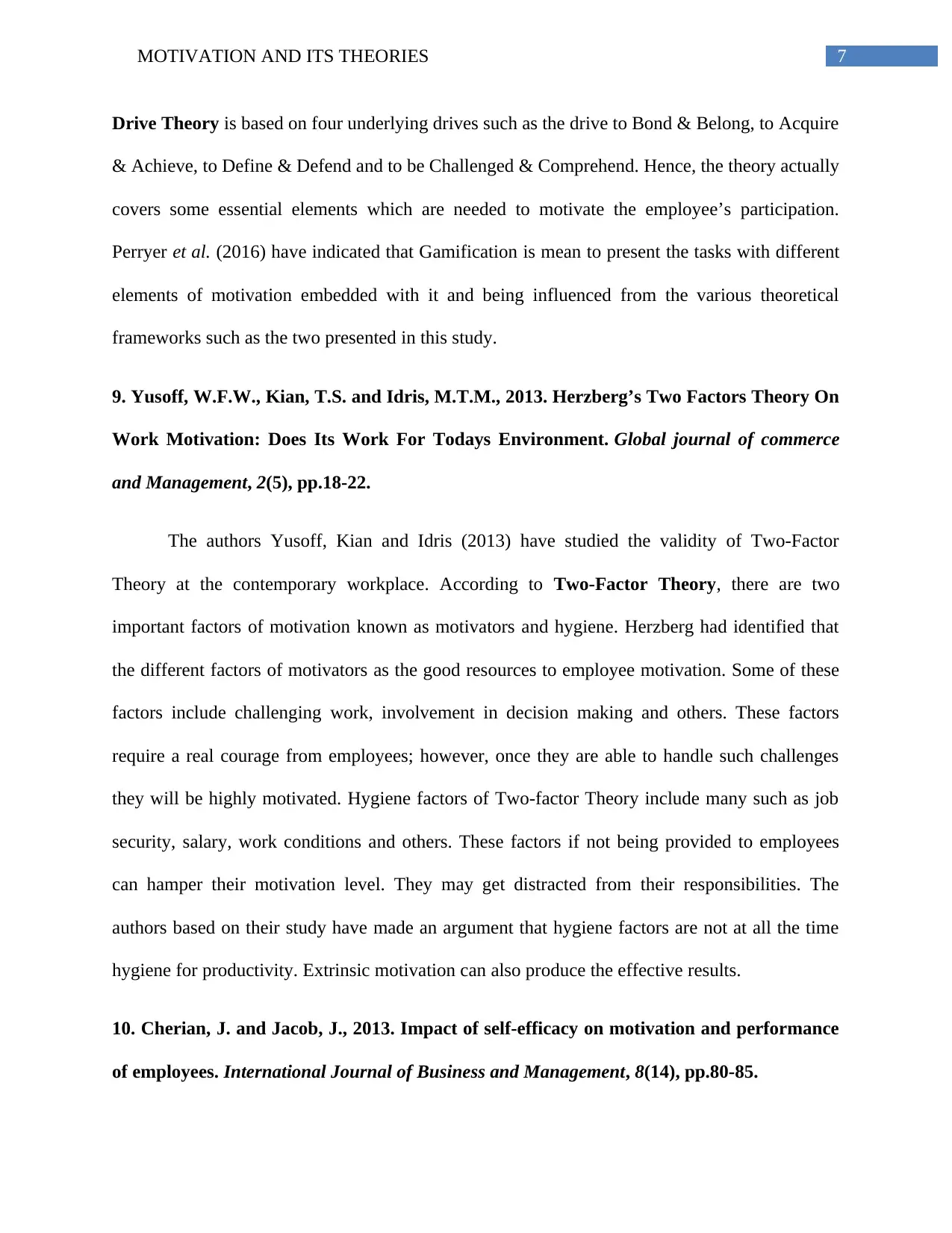
7MOTIVATION AND ITS THEORIES
Drive Theory is based on four underlying drives such as the drive to Bond & Belong, to Acquire
& Achieve, to Define & Defend and to be Challenged & Comprehend. Hence, the theory actually
covers some essential elements which are needed to motivate the employee’s participation.
Perryer et al. (2016) have indicated that Gamification is mean to present the tasks with different
elements of motivation embedded with it and being influenced from the various theoretical
frameworks such as the two presented in this study.
9. Yusoff, W.F.W., Kian, T.S. and Idris, M.T.M., 2013. Herzberg’s Two Factors Theory On
Work Motivation: Does Its Work For Todays Environment. Global journal of commerce
and Management, 2(5), pp.18-22.
The authors Yusoff, Kian and Idris (2013) have studied the validity of Two-Factor
Theory at the contemporary workplace. According to Two-Factor Theory, there are two
important factors of motivation known as motivators and hygiene. Herzberg had identified that
the different factors of motivators as the good resources to employee motivation. Some of these
factors include challenging work, involvement in decision making and others. These factors
require a real courage from employees; however, once they are able to handle such challenges
they will be highly motivated. Hygiene factors of Two-factor Theory include many such as job
security, salary, work conditions and others. These factors if not being provided to employees
can hamper their motivation level. They may get distracted from their responsibilities. The
authors based on their study have made an argument that hygiene factors are not at all the time
hygiene for productivity. Extrinsic motivation can also produce the effective results.
10. Cherian, J. and Jacob, J., 2013. Impact of self-efficacy on motivation and performance
of employees. International Journal of Business and Management, 8(14), pp.80-85.
Drive Theory is based on four underlying drives such as the drive to Bond & Belong, to Acquire
& Achieve, to Define & Defend and to be Challenged & Comprehend. Hence, the theory actually
covers some essential elements which are needed to motivate the employee’s participation.
Perryer et al. (2016) have indicated that Gamification is mean to present the tasks with different
elements of motivation embedded with it and being influenced from the various theoretical
frameworks such as the two presented in this study.
9. Yusoff, W.F.W., Kian, T.S. and Idris, M.T.M., 2013. Herzberg’s Two Factors Theory On
Work Motivation: Does Its Work For Todays Environment. Global journal of commerce
and Management, 2(5), pp.18-22.
The authors Yusoff, Kian and Idris (2013) have studied the validity of Two-Factor
Theory at the contemporary workplace. According to Two-Factor Theory, there are two
important factors of motivation known as motivators and hygiene. Herzberg had identified that
the different factors of motivators as the good resources to employee motivation. Some of these
factors include challenging work, involvement in decision making and others. These factors
require a real courage from employees; however, once they are able to handle such challenges
they will be highly motivated. Hygiene factors of Two-factor Theory include many such as job
security, salary, work conditions and others. These factors if not being provided to employees
can hamper their motivation level. They may get distracted from their responsibilities. The
authors based on their study have made an argument that hygiene factors are not at all the time
hygiene for productivity. Extrinsic motivation can also produce the effective results.
10. Cherian, J. and Jacob, J., 2013. Impact of self-efficacy on motivation and performance
of employees. International Journal of Business and Management, 8(14), pp.80-85.
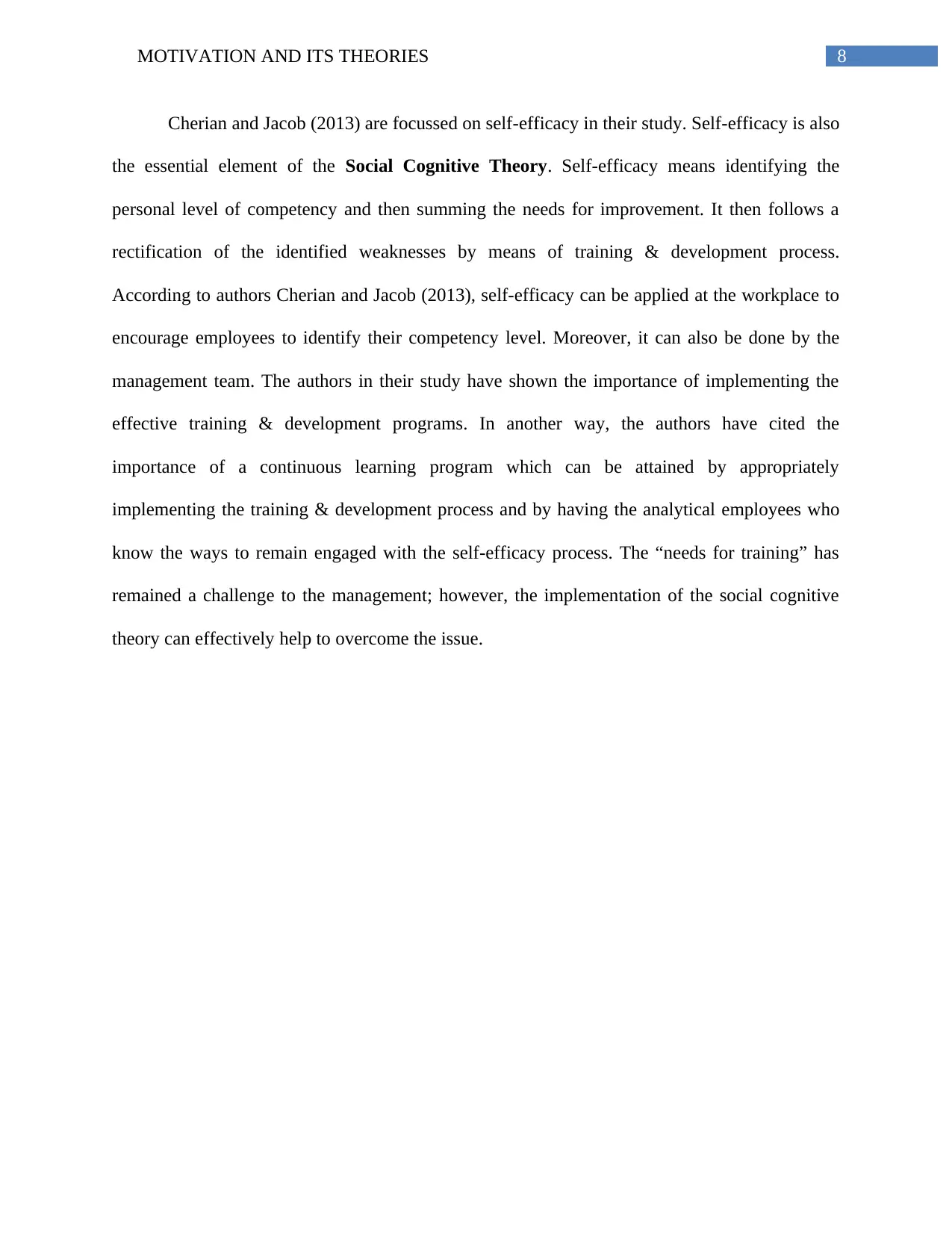
8MOTIVATION AND ITS THEORIES
Cherian and Jacob (2013) are focussed on self-efficacy in their study. Self-efficacy is also
the essential element of the Social Cognitive Theory. Self-efficacy means identifying the
personal level of competency and then summing the needs for improvement. It then follows a
rectification of the identified weaknesses by means of training & development process.
According to authors Cherian and Jacob (2013), self-efficacy can be applied at the workplace to
encourage employees to identify their competency level. Moreover, it can also be done by the
management team. The authors in their study have shown the importance of implementing the
effective training & development programs. In another way, the authors have cited the
importance of a continuous learning program which can be attained by appropriately
implementing the training & development process and by having the analytical employees who
know the ways to remain engaged with the self-efficacy process. The “needs for training” has
remained a challenge to the management; however, the implementation of the social cognitive
theory can effectively help to overcome the issue.
Cherian and Jacob (2013) are focussed on self-efficacy in their study. Self-efficacy is also
the essential element of the Social Cognitive Theory. Self-efficacy means identifying the
personal level of competency and then summing the needs for improvement. It then follows a
rectification of the identified weaknesses by means of training & development process.
According to authors Cherian and Jacob (2013), self-efficacy can be applied at the workplace to
encourage employees to identify their competency level. Moreover, it can also be done by the
management team. The authors in their study have shown the importance of implementing the
effective training & development programs. In another way, the authors have cited the
importance of a continuous learning program which can be attained by appropriately
implementing the training & development process and by having the analytical employees who
know the ways to remain engaged with the self-efficacy process. The “needs for training” has
remained a challenge to the management; however, the implementation of the social cognitive
theory can effectively help to overcome the issue.
⊘ This is a preview!⊘
Do you want full access?
Subscribe today to unlock all pages.

Trusted by 1+ million students worldwide
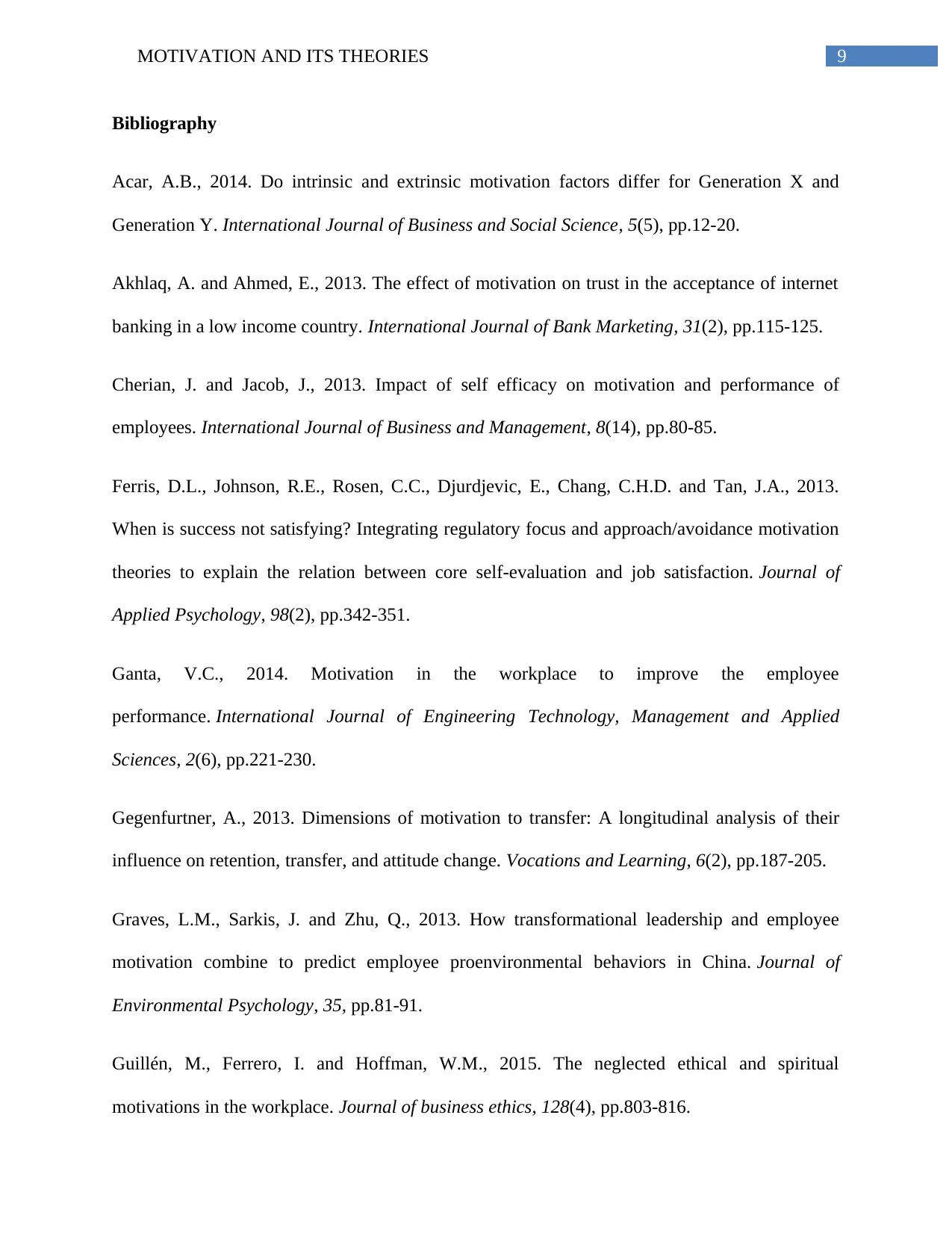
9MOTIVATION AND ITS THEORIES
Bibliography
Acar, A.B., 2014. Do intrinsic and extrinsic motivation factors differ for Generation X and
Generation Y. International Journal of Business and Social Science, 5(5), pp.12-20.
Akhlaq, A. and Ahmed, E., 2013. The effect of motivation on trust in the acceptance of internet
banking in a low income country. International Journal of Bank Marketing, 31(2), pp.115-125.
Cherian, J. and Jacob, J., 2013. Impact of self efficacy on motivation and performance of
employees. International Journal of Business and Management, 8(14), pp.80-85.
Ferris, D.L., Johnson, R.E., Rosen, C.C., Djurdjevic, E., Chang, C.H.D. and Tan, J.A., 2013.
When is success not satisfying? Integrating regulatory focus and approach/avoidance motivation
theories to explain the relation between core self-evaluation and job satisfaction. Journal of
Applied Psychology, 98(2), pp.342-351.
Ganta, V.C., 2014. Motivation in the workplace to improve the employee
performance. International Journal of Engineering Technology, Management and Applied
Sciences, 2(6), pp.221-230.
Gegenfurtner, A., 2013. Dimensions of motivation to transfer: A longitudinal analysis of their
influence on retention, transfer, and attitude change. Vocations and Learning, 6(2), pp.187-205.
Graves, L.M., Sarkis, J. and Zhu, Q., 2013. How transformational leadership and employee
motivation combine to predict employee proenvironmental behaviors in China. Journal of
Environmental Psychology, 35, pp.81-91.
Guillén, M., Ferrero, I. and Hoffman, W.M., 2015. The neglected ethical and spiritual
motivations in the workplace. Journal of business ethics, 128(4), pp.803-816.
Bibliography
Acar, A.B., 2014. Do intrinsic and extrinsic motivation factors differ for Generation X and
Generation Y. International Journal of Business and Social Science, 5(5), pp.12-20.
Akhlaq, A. and Ahmed, E., 2013. The effect of motivation on trust in the acceptance of internet
banking in a low income country. International Journal of Bank Marketing, 31(2), pp.115-125.
Cherian, J. and Jacob, J., 2013. Impact of self efficacy on motivation and performance of
employees. International Journal of Business and Management, 8(14), pp.80-85.
Ferris, D.L., Johnson, R.E., Rosen, C.C., Djurdjevic, E., Chang, C.H.D. and Tan, J.A., 2013.
When is success not satisfying? Integrating regulatory focus and approach/avoidance motivation
theories to explain the relation between core self-evaluation and job satisfaction. Journal of
Applied Psychology, 98(2), pp.342-351.
Ganta, V.C., 2014. Motivation in the workplace to improve the employee
performance. International Journal of Engineering Technology, Management and Applied
Sciences, 2(6), pp.221-230.
Gegenfurtner, A., 2013. Dimensions of motivation to transfer: A longitudinal analysis of their
influence on retention, transfer, and attitude change. Vocations and Learning, 6(2), pp.187-205.
Graves, L.M., Sarkis, J. and Zhu, Q., 2013. How transformational leadership and employee
motivation combine to predict employee proenvironmental behaviors in China. Journal of
Environmental Psychology, 35, pp.81-91.
Guillén, M., Ferrero, I. and Hoffman, W.M., 2015. The neglected ethical and spiritual
motivations in the workplace. Journal of business ethics, 128(4), pp.803-816.
Paraphrase This Document
Need a fresh take? Get an instant paraphrase of this document with our AI Paraphraser
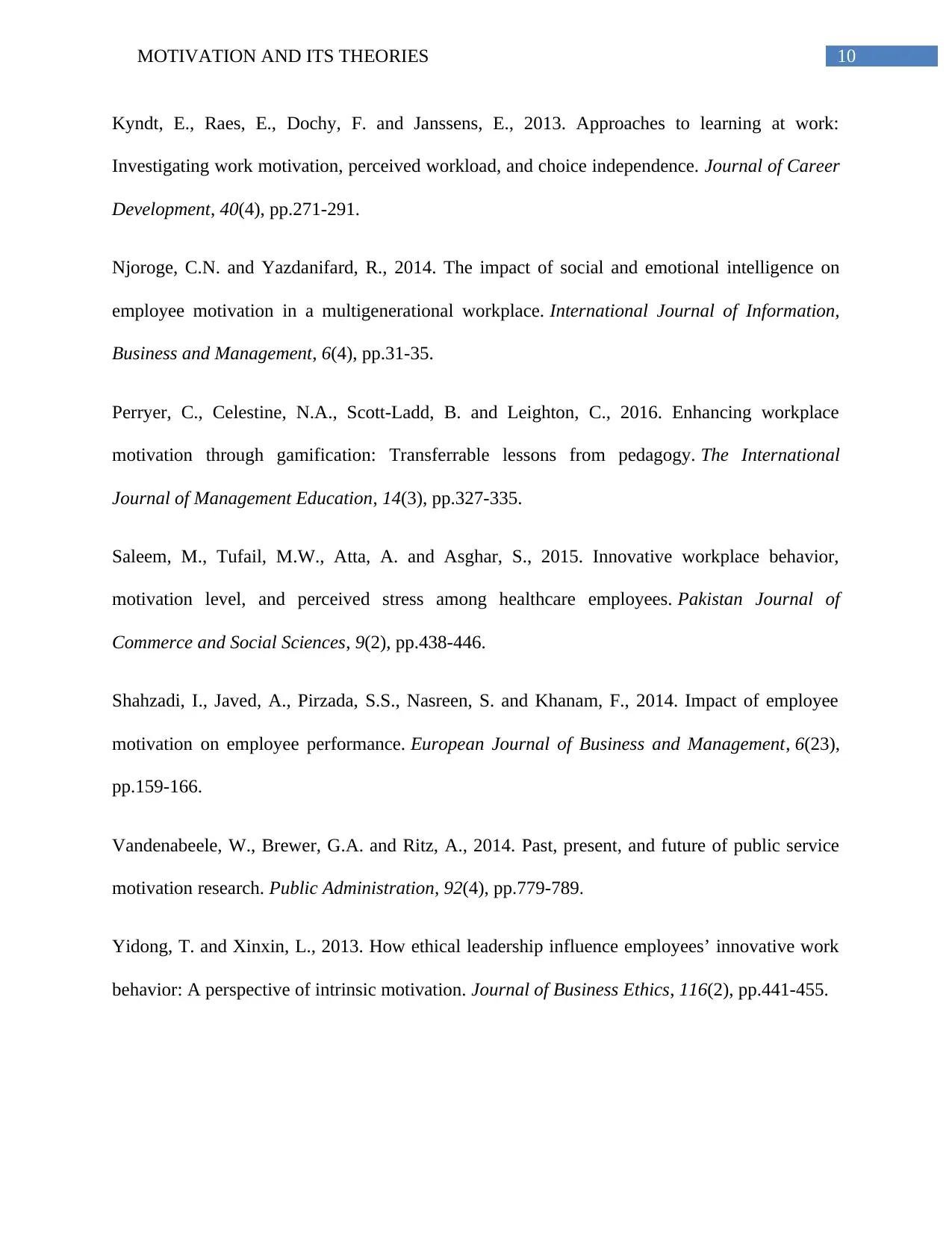
10MOTIVATION AND ITS THEORIES
Kyndt, E., Raes, E., Dochy, F. and Janssens, E., 2013. Approaches to learning at work:
Investigating work motivation, perceived workload, and choice independence. Journal of Career
Development, 40(4), pp.271-291.
Njoroge, C.N. and Yazdanifard, R., 2014. The impact of social and emotional intelligence on
employee motivation in a multigenerational workplace. International Journal of Information,
Business and Management, 6(4), pp.31-35.
Perryer, C., Celestine, N.A., Scott-Ladd, B. and Leighton, C., 2016. Enhancing workplace
motivation through gamification: Transferrable lessons from pedagogy. The International
Journal of Management Education, 14(3), pp.327-335.
Saleem, M., Tufail, M.W., Atta, A. and Asghar, S., 2015. Innovative workplace behavior,
motivation level, and perceived stress among healthcare employees. Pakistan Journal of
Commerce and Social Sciences, 9(2), pp.438-446.
Shahzadi, I., Javed, A., Pirzada, S.S., Nasreen, S. and Khanam, F., 2014. Impact of employee
motivation on employee performance. European Journal of Business and Management, 6(23),
pp.159-166.
Vandenabeele, W., Brewer, G.A. and Ritz, A., 2014. Past, present, and future of public service
motivation research. Public Administration, 92(4), pp.779-789.
Yidong, T. and Xinxin, L., 2013. How ethical leadership influence employees’ innovative work
behavior: A perspective of intrinsic motivation. Journal of Business Ethics, 116(2), pp.441-455.
Kyndt, E., Raes, E., Dochy, F. and Janssens, E., 2013. Approaches to learning at work:
Investigating work motivation, perceived workload, and choice independence. Journal of Career
Development, 40(4), pp.271-291.
Njoroge, C.N. and Yazdanifard, R., 2014. The impact of social and emotional intelligence on
employee motivation in a multigenerational workplace. International Journal of Information,
Business and Management, 6(4), pp.31-35.
Perryer, C., Celestine, N.A., Scott-Ladd, B. and Leighton, C., 2016. Enhancing workplace
motivation through gamification: Transferrable lessons from pedagogy. The International
Journal of Management Education, 14(3), pp.327-335.
Saleem, M., Tufail, M.W., Atta, A. and Asghar, S., 2015. Innovative workplace behavior,
motivation level, and perceived stress among healthcare employees. Pakistan Journal of
Commerce and Social Sciences, 9(2), pp.438-446.
Shahzadi, I., Javed, A., Pirzada, S.S., Nasreen, S. and Khanam, F., 2014. Impact of employee
motivation on employee performance. European Journal of Business and Management, 6(23),
pp.159-166.
Vandenabeele, W., Brewer, G.A. and Ritz, A., 2014. Past, present, and future of public service
motivation research. Public Administration, 92(4), pp.779-789.
Yidong, T. and Xinxin, L., 2013. How ethical leadership influence employees’ innovative work
behavior: A perspective of intrinsic motivation. Journal of Business Ethics, 116(2), pp.441-455.
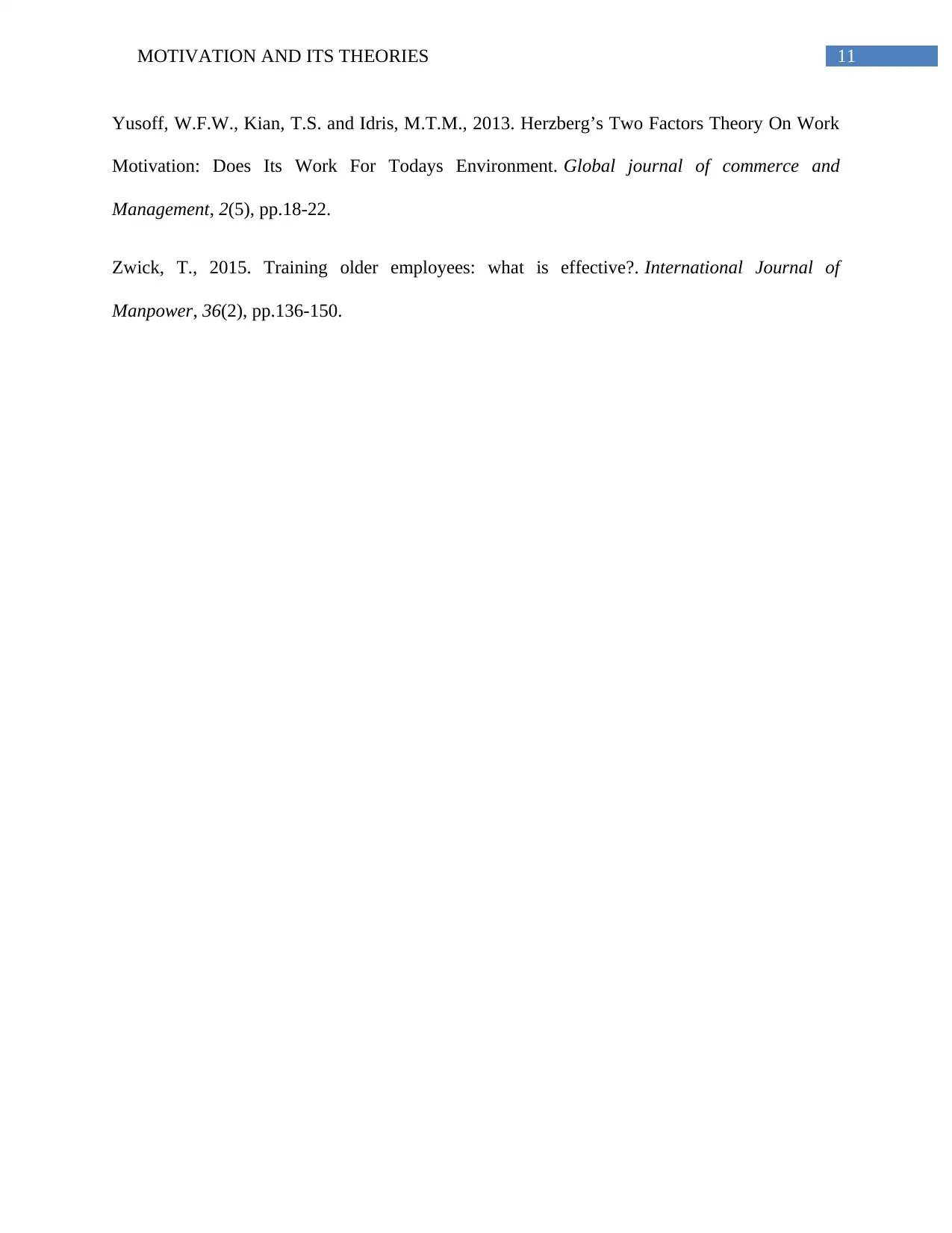
11MOTIVATION AND ITS THEORIES
Yusoff, W.F.W., Kian, T.S. and Idris, M.T.M., 2013. Herzberg’s Two Factors Theory On Work
Motivation: Does Its Work For Todays Environment. Global journal of commerce and
Management, 2(5), pp.18-22.
Zwick, T., 2015. Training older employees: what is effective?. International Journal of
Manpower, 36(2), pp.136-150.
Yusoff, W.F.W., Kian, T.S. and Idris, M.T.M., 2013. Herzberg’s Two Factors Theory On Work
Motivation: Does Its Work For Todays Environment. Global journal of commerce and
Management, 2(5), pp.18-22.
Zwick, T., 2015. Training older employees: what is effective?. International Journal of
Manpower, 36(2), pp.136-150.
⊘ This is a preview!⊘
Do you want full access?
Subscribe today to unlock all pages.

Trusted by 1+ million students worldwide
1 out of 12
Related Documents
Your All-in-One AI-Powered Toolkit for Academic Success.
+13062052269
info@desklib.com
Available 24*7 on WhatsApp / Email
![[object Object]](/_next/static/media/star-bottom.7253800d.svg)
Unlock your academic potential
Copyright © 2020–2025 A2Z Services. All Rights Reserved. Developed and managed by ZUCOL.





